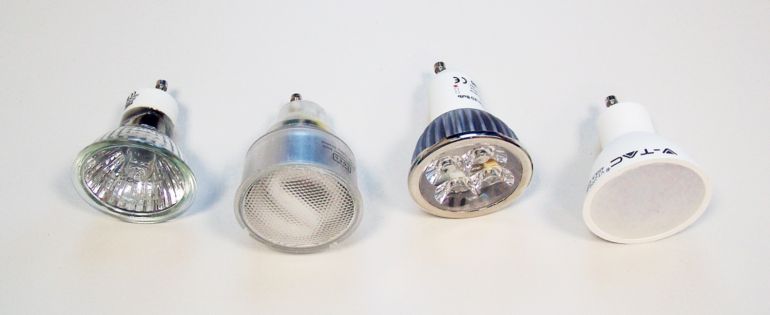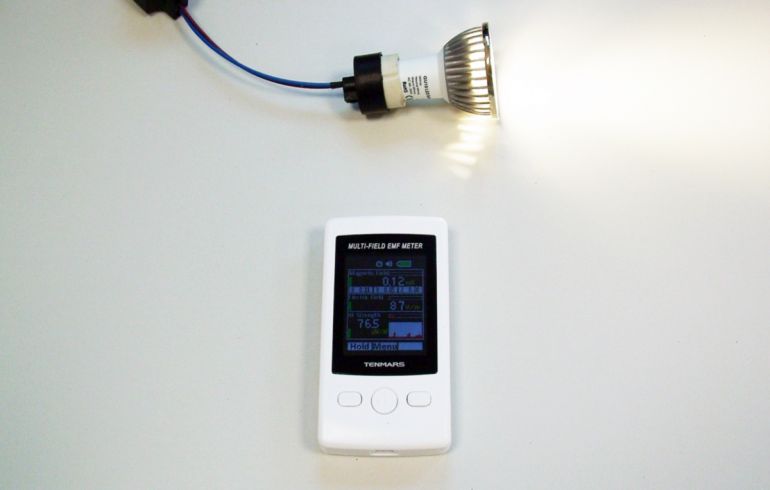We continue our collection of informative articles regarding electrosmog. Today it is the turn of LED bulbs, which are very fashionable nowadays and which can be a good replacement for traditional halogen incandescent bulbs. We thank our followers who suggested we also deal with this topic.
For those who missed them, we recommend reading the previous articles regarding theelectrosmog, in which we carried out measurements on household appliances and electrical systems.
Measurements of electrosmog produced by LED bulbs
Let's get to the heart of the measurements carried out on two types of LED bulbs:
– globe bulbs with E27 socket
– spotlights with GU10 connection
On the display of the electromagnetic field measuring instrument we find three fundamental data:
– magnetic induction, measured in mG (milliGauss)
– the electric field, measured in V/m (Volts per meter)
– the power density of the radio frequency electromagnetic field, measured in uW/m2 (microWatts per square meter)
From the measurements carried out, the environmental electrosmog values have already been subtracted, in order to understand the actual emissions of the various LED bulbs.
|
Bulb type |
mG |
V/m |
uW/m2 |
|
E27 incandescent lamp |
0 |
0 |
0 |
|
E27 globe LED bulb (8W) |
0 |
13 |
5 |
|
E27 globe LED bulb (12W) |
2 |
50 |
27 |

From the measurements of the electrosmog produced by globe LED bulbs with E27 socket, it appears that the one with the lowest emissions is precisely the old incandescent halogen bulb. Strangely, we don't even measure the electric field we might have expected. Regarding LED bulbs, we find higher electrosmog values, which are not dangerous, especially considering that the measurements were carried out at close range, while the bulbs are normally located at a considerable distance from the human body.
|
Bulb type |
mG |
V/m |
uW/m2 |
|
GU10 incandescent lamp |
0 |
122 |
0 |
|
GU10 fluorescent CFL lamp |
2,7 |
66 |
6 |
|
Lampadina a LED GU10 (1) |
0 |
72 |
61 |
|
Lampadina a LED GU10 (2) |
0 |
56 |
3 |
From the measurements of the electrosmog produced by LED spotlight bulbs with GU10 socket, we have more conflicting data compared to the measurements of globe bulbs.

First we find that the electric field is greater on the incandescent bulb. The CFL fluorescent lamp is the one that holds the negative record for magnetic induction (certainly caused by an internal transformer), while we find radio frequency emission on one of the two LED spotlights. This emission is certainly caused by the power supply inside the bulb which, being switching, works at high frequency.

The measured values are not dangerous, However, we would advise you to leave light bulbs that emit radio frequencies off during the night. By installing the bulbs at a safe distance from the human body, emissions are negligible.
So can we give LED bulbs a positive rating?
Compared to measurements carried out on other household appliances, the measurements of electrosmog produced by LED bulbs are less worrying. From an electromagnetic point of view, with the precautions described above, it is possible to easily install LED bulbs in your home.
A problem arises regarding the life of the bulbs. Many of the light bulbs we tested, even if they were of a good brand, suffered sudden failures shortly after installation. Some light bulbs were already broken upon receipt. Others failed after just a few hours of operation. The promised durations of 15,000-30,000 hours are never true, also because, if it is true that the LED lasts several thousand hours, it is not equally true that the power supply lasts: the component used to supply the right current to the LEDs. In fact, in LED bulbs, it is almost always the power supply that fails first.
The environmental damage in this case is high: you buy light bulbs that use more polluting materials than a traditional incandescent light bulb and which, in some cases, last even less. The economic damage is also greater: if it is true that LED bulbs consume a tenth of the electricity consumed by a traditional one, it is also true that they cost several times more.
With the Control Casa home automation system it is possible to impose a maximum voltage value to drive the dimmers of the LED bulbs. In this case, by never turning on at maximum power, it is possible to increase its duration. Compared to incandescent bulbs, LED bulbs do not change color when they reduce the light intensity. Obviously the LED bulb must be designed to be connected to dimmers. With the Control Casa home automation system it is also possible to automate the management of lights, with automatic switching on and timers to turn off the light bulbs when there are no people passing by or at set times.
We leave the verdict to the readers: LED bulbs yes or no?